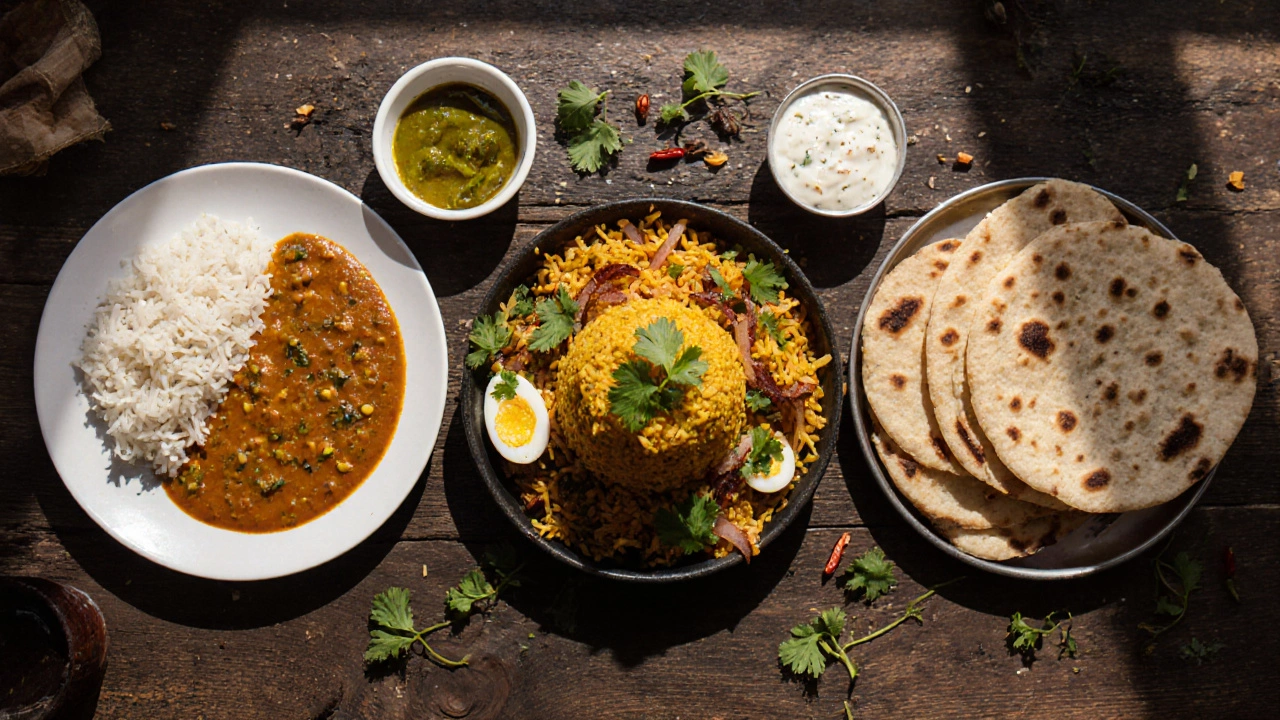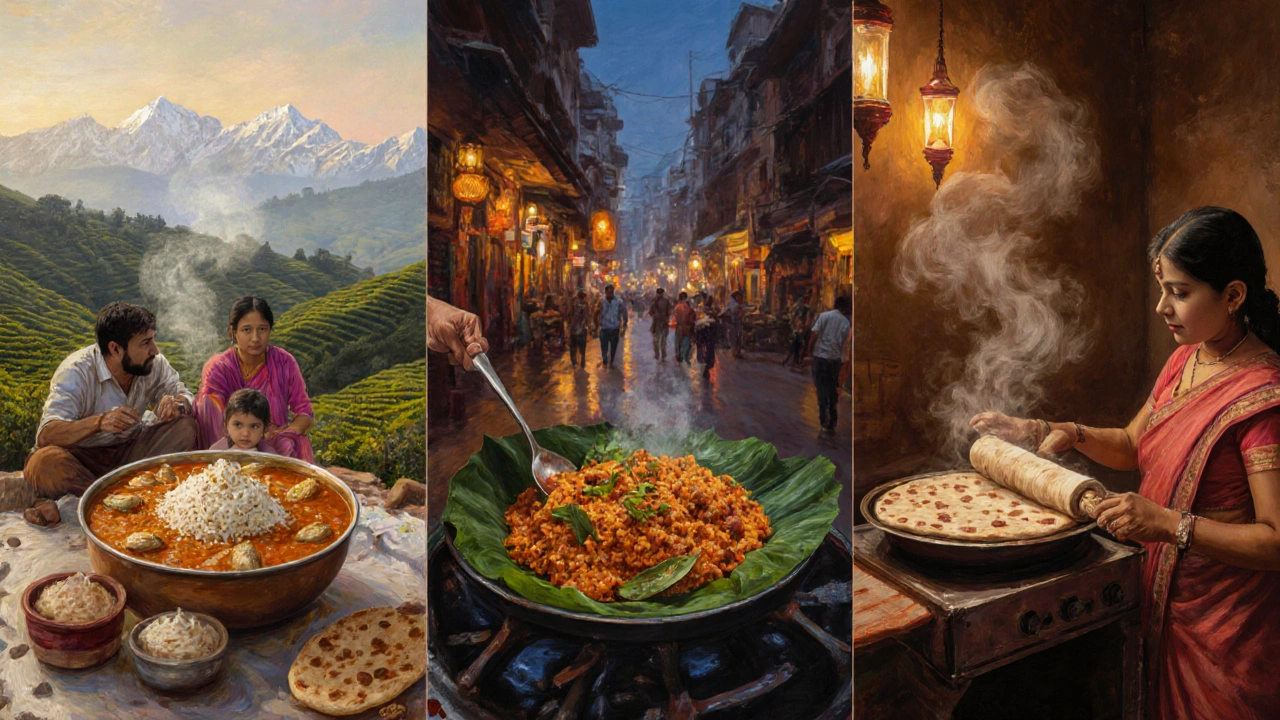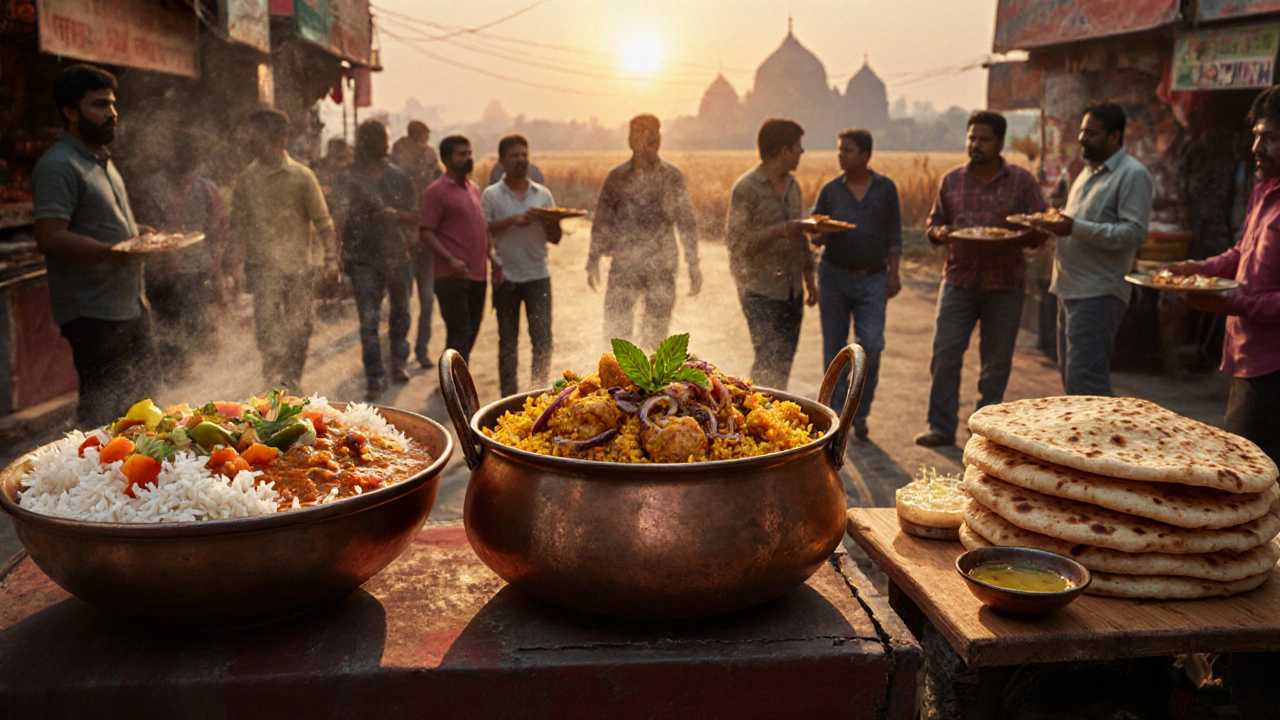India's National Dish Comparison Tool
Dal Bhat
Biryani
Roti
Compare Your Priorities
Key Takeaways
- India has no officially declared national dish.
- The most frequently mentioned candidates are dal bhat, biryani and roti.
- Each contender reflects a different region, history and everyday life.
- You can recreate a basic version of each at home with simple ingredients.
- Understanding the debate gives deeper insight into India’s culinary diversity.
When you hear people ask "What is India national dish?" the answer isn’t a single, government‑approved staple. Instead, the conversation opens a window onto the country’s vast food landscape, from the rice fields of the south to the wheat farms of the north.
India is a South Asian nation with more than 1.4billion people, over 2,000 distinct ethnic groups and a culinary tradition that stretches back millennia. Because of that breadth, pinning down one national dish is a tricky exercise-yet three foods keep popping up in the debate.
No Official Designation - Why the Question Persists
Unlike countries such as Japan (sushi) or Mexico (tacos), India never passed a law or cultural decree naming a national dish. The Ministry of Culture has repeatedly said food heritage is a shared responsibility, not a single emblem.
Still, media outlets, travel guides and food blogs love a good shortcut, so they crown a “national dish” based on popularity, cultural symbolism or historical roots. That’s where the three heavyweights-dal bhat, biryani and roti-enter the arena.

The Top Contenders
Dal Bhat: The Comfort Meal of the East and Himalayas
Dal bhat is a simple plate of boiled rice (bhat) served with seasoned lentils (dal), often accompanied by vegetables, pickles and sometimes meat. It is the daily staple in Nepal, the Indian state of West Bengal, and the northeastern states of Assam and Manipur. The dish’s strength lies in its balance of protein (lentils) and carbs (rice), making it a nutritious, budget‑friendly meal for families.
Key ingredients: split red lentils (masoor dal or toor dal), garlic, ginger, cumin, turmeric, mustard seeds, and long‑grain rice. Cooking time averages 30minutes, and the flavor profile ranges from mildly spiced to fiery, depending on the regional chili level.
Biryani: The Royal Feast of the Subcontinent
Biryani is a layered rice dish cooked with marinated meat (chicken, mutton, beef, or shrimp), aromatic spices, and sometimes boiled eggs or vegetables. Its origins trace back to Mughal courts in the 16thcentury, blending Persian pilaf techniques with Indian spices. Today, regional twists-Hyderabadi, Lucknowi (Awadhi), Kolkata, Malabar-each claim the title of the most authentic version.
Typical spices: saffron, cardamom, cloves, bay leaves, cinnamon, and garam masala. The dish is often served on special occasions, weddings, and during the month of Ramadan. Because of its richness, a serving can contain 600‑800kcal.
Roti (and Its Cousins): The Everyday Bread
Roti (also known as chapati) is an unleavened flatbread made from whole‑wheat flour, water and a pinch of salt, cooked on a hot griddle (tava). It is the most common accompaniment to vegetable curries, dals and meats across northern India, Pakistan and Bangladesh.
What makes roti a contender is its ubiquity: an estimated 70percent of Indian households serve fresh roti at every meal. It’s cheap, high‑in‑fiber, and can be cooked in under five minutes once the dough is ready.
How Each Dish Mirrors Regional Culture
Beyond taste, these dishes tell stories about geography, climate and history.
- Dal bhat thrives in areas where rice paddies and lentil fields coexist, reflecting agrarian cycles and communal dining.
- Biryani carries the imprint of empire-spices that arrived via trade routes, cooking methods from Persian kitchens, and local adaptations that showcase regional produce.
- Roti embodies the wheat‑growing plains of the Indo‑Gangetic basin, where the staple grain has shaped daily life for centuries.
Even the side dishes matter. In the south, you’ll find coconut‑based sambars alongside dal bhat; in the west, pickled mangoes add a tangy kick to biryani; in Punjab, butter‑laden dal pairs with butter‑rich roti.
Simple Home‑Style Recipes (Basic Versions)
Quick Dal Bhat
- Rinse 1cup of split red lentils; soak for 10minutes.
- Boil 2cups of water, add lentils, ½tsp turmeric, and a pinch of salt. Simmer 15minutes.
- In a separate pan, heat 1tbsp oil, add ½tsp mustard seeds, a pinch of asafoetida, 2 minced garlic cloves, and 1inch grated ginger. Fry 30seconds.
- Stir the tempering into the cooked dal, add fresh cilantro and a squeeze of lemon.
- Serve over steamed white rice, accompanied by a side of sautéed greens or a simple cucumber pickle.
Basic Chicken Biryani
- Marinate 500g chicken pieces with yogurt, 1tbsp ginger‑garlic paste, 1tsp garam masala, and a pinch of salt for 30minutes.
- Parboil 1½cups basmati rice with 2‑3 cardamom pods, 1bay leaf, and a pinch of saffron threads.
- In a deep pot, heat 2tbsp ghee, add sliced onions, fry until golden. Add the marinated chicken and cook 10minutes.
- Layer the partially cooked rice over the chicken, drizzle a little ghee, and cover tightly. Cook on low heat (dum) for 20minutes.
- Garnish with fried onions, fresh mint, and serve with raita (yogurt‑cucumber dip).
Everyday Roti
- Combine 2cups whole‑wheat flour with a pinch of salt and ¾cup warm water. Knead into a smooth dough; rest 15minutes.
- Divide dough into golf‑ball sized balls, roll each into a 6‑inch circle.
- Heat a dry tava or skillet over medium‑high heat. Cook each roti for ~30seconds on each side, then press gently with a cloth to puff up.
- Brush lightly with melted ghee or butter if desired and serve hot.

Where to Taste the Classics Today
Traveling through India offers countless chances to sample each dish in its native context.
- Dal bhat: Roadside dhabas in West Bengal, tea stalls in Assam, and hill‑top eateries in Darjeeling serve steaming plates.
- Biryani: The historic Old City of Hyderabad, Lucknow’s culinary lanes, and Kolkata’s famous “Amin’s” restaurant are pilgrimage spots for biryani lovers.
- Roti: Almost any family kitchen, street vendor, or Punjabi dhaba will hand you fresh roti alongside butter‑rich dal.
Many Indian restaurants abroad (including in Sydney, where Indian food has a strong presence) list these dishes prominently, often labeling one as the “national dish” for tourists. While helpful, it’s a simplification of a far richer story.
Comparison of the Main Contenders
| Dish | Main Ingredient | Typical Region | Serving Style | Approx. Prep Time |
|---|---|---|---|---|
| Dal Bhat | Lentils + Rice | East & Himalayas | Plate with side vegetables & pickles | 30min |
| Biryani | Marinated Meat + Basmati Rice | South & North (Hyderabad, Lucknow, Kolkata) | Layered, often served with raita & boiled eggs | 45‑60min |
| Roti | Whole‑wheat Flour | North & Central Plains | Paired with curries, dal or kebabs | 10‑15min (excluding dough rest) |
Frequently Asked Questions
Does India officially have a national dish?
No. The Indian government has never proclaimed an official national dish. The idea is a media‑driven shortcut to represent the country’s food culture.
Why do many people say dal bhat is the national dish?
Dal bhat is a staple for millions in the eastern states and Himalayan regions. Its combination of protein‑rich lentils and carbohydrate‑dense rice makes it a everyday comfort meal, which is why it’s often highlighted as a representative dish.
Is biryani considered a celebration dish?
Yes. Biryani’s rich spices, expensive meat cuts and labor‑intensive layering make it a festive choice for weddings, festivals and special gatherings across the subcontinent.
Can roti be made without a tawa?
While a hot tawa or skillet gives the best puff and texture, you can also bake roti in a pre‑heated oven or use a microwave‑friendly method for a quick alternative.
Which dish is the healthiest choice?
Dal bhat generally tops the health chart because of its balanced protein‑to‑carb ratio and minimal use of oil or ghee. Adding fresh vegetables increases its nutrient profile.
